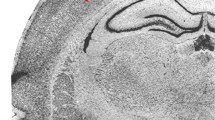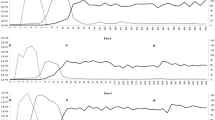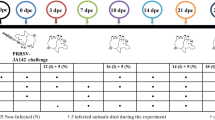Abstract
We investigated the effect of a primary non-lethal infection with lymphocytic choriomeningitis virus (LCMV) on the course and outcome of a secondary infection with the Gram-negative Salmonella enterica serovar Typhimurium or the Gram-positive Listeria monocytogenes in mice. We found that at each stage of the viral infection the susceptibility of mice to bacterial super-infections changes dramatically and depends also on whether the secondary infection is a Gram-positive or Gram-negative one. The study shows that the outcome of the secondary infection is determined by a delicate balance between the overproduction of and the hypersensitivity to inflammatory cytokines (TNF-α and IFN-γ), as well as by the changes in blood leukocytes occurring in mice in the course of viral infection.






Similar content being viewed by others
References
Akira S, Sato S (2003) Toll-like receptors and their signaling mechanisms. Scand J Infect Dis 35:555–562
Della Chiesa M, Sivori S, Castriconi R, Marcenaro E, Moretta A (2005) Pathogen-induced private conversations between natural killer and dendritic cells. Trends Microbiol 13:128–136
Beutler B, Rietschel ET (2003) Innate immune sensing and its roots: the story of endotoxin. Nat Rev Immunol 3:169–176
Poltorak A, He X, Smirnova I, Liu MY, Van Huffel C, Du X, Birdwell D, Alejos E, Silva M, Galanos C, Freudenberg M, Ricciardi-Castagnoli P, Layton B, Beutler B (1998) Defective LPS signaling in C3H/HeJ and C57BL/10ScCr mice: mutations in Tlr4 gene. Science 282:2085–2088
Kalis C, Kanzler B, Lembo A, Poltorak A, Galanos C, Freudenberg MA (2003) Toll-like receptor 4 expression levels determine the degree of LPS-susceptibility in mice. Eur J Immunol 33:798–805
Freudenberg MA, Merlin T, Gumenscheimer M, Kalis C, Landmann R, Galanos C (2001) Role of lipopolysaccharide susceptibility in the innate immune response to Salmonella typhimurium infection: LPS, a primary target for recognition of Gram-negative bacteria. Microbes Infect 3:1213–1222
von Jeney N, Gunther E, Jann K (1977) Mitogenic stimulation of murine spleen cells: relation to susceptibility to Salmonella infection. Infect Immun 15:26–33
Cross AS, Sadoff JC, Kelly N, Bernton E, Gemski P (1989) Pretreatment with recombinant murine tumor necrosis factor alpha/cachectin and murine interleukin 1 alpha protects mice from lethal bacterial infection. J Exp Med 169:2021–2027
Parant M, Parant F, Chedid L (1977) Inheritance of lipopolysaccharide-enhanced nonspecific resistance to infection and of susceptibility to endotoxic shock in lipopolysaccharide low-responder mice. Infect Immun 16:432–438
Gumenscheimer M, Mitov I, Galanos C, Freudenberg MA (2002) Beneficial or deleterious effects of a preexisting hypersensitivity to bacterial components on the course and outcome of infection. Infect Immun 70:5596–5603
Galanos C, Freudenberg MA, Katschinski T, Salomao R, Mossmann H, Kumazawa Y (1992) Tumor necrosis factor and host response to endotoxin. In: Ryan JL, Morrison DC (eds) Bacterial endotoxic lipopolysaccharides. CRC, Boca Raton, pp 73–104
Heinzel FP (1990) The role of IFN-gamma in the pathology of experimental endotoxemia. J Immunol 145:2920–2924
Ishibashi Y, Arai T (1990) Effect of gamma-interferon on phagosome–lysosome fusion in Salmonella typhimurium-infected murine macrophages. FEMS Microbiol Immunol 2:75–82
Nauciel C, Espinasse-Maes F (1992) Role of gamma interferon and tumor necrosis factor alpha in resistance to Salmonella typhimurium infection. Infect Immun 60:450–454
Tracey KJ, Cerami A (1994) Tumor necrosis factor: a pleiotropic cytokine and therapeutic target. Annu Rev Med 45:491–503
Chambaud I, Wroblewski H, Blanchard A (1999) Interactions between mycoplasma lipoproteins and the host immune system. Trends Microbiol 7:493–499
Galanos C, Gumenscheimer M, Mühlradt PF, Jirillo E, Freudenberg MA (2000) MALP-2, a Mycoplasma lipopeptide with classical endotoxic properties: end of an era of LPS monopoly? J Endotox Res 6:471–476
Krieg AM, Yi AK, Matson S, Waldschmidt TJ, Bishop GA, Teasdale R, Koretzky GA, Klinman DM (1995) CpG motifs in bacterial DNA trigger direct B-cell activation. Nature 374:546–549
Lipford GB, Heeg K, Wagner H (1998) Bacterial DNA as immune cell activator. Trends Microbiol 6:496–500
Halpern BN, Prevot AR, Biozzi G, Stiffel C, Mouton D, Morard JC, Bouthillier Y, Decreusefond C (1964) Stimulation of the phagocytic activity of the reticuloendothelial system by Corynebacterium Parvum. J Reticuloendothel Soc 83:77–96
Nansen A, Christensen JP, Marker O, Thomsen AR (1997) Sensitization to lipopolysaccharide in mice with asymptomatic viral infection: role of T cell-dependent production of interferon-gamma. J Infect Dis 176:151–157
Nansen A, Randrup Thomsen A (2001) Viral infection causes rapid sensitization to lipopolysaccharide: central role of IFN-alpha beta. J Immunol 166:982–998
Katschinski T, Galanos C, Coumbos A, Freudenberg MA (1992) Gamma interferon mediates Propionibacterium acnes-induced hypersensitivity to lipopolysaccharide in mice. Infect Immun 60:1994–2001
Lembo A, Kalis C, Kirschning CJ, Mitolo V, Jirillo E, Wagner H, Galanos C, Freudenberg MA (2003) Differential contribution of Toll-like receptors 4 and 2 to the cytokine response to Salmonella enterica serovar Typhimurium and Staphylococcus aureus in mice. Infect Immun 71:6058–6062
Merlin T, Gumenscheimer M, Galanos C, Freudenberg MA (2001) TNF-alpha hyper-responses to Gram-negative and Gram-positive bacteria in Propionibacterium acnes primed or Salmonella typhimurium infected mice. J Endotoxin Res 7:157–163
Freudenberg MA, Galanos C (1996) Lipopolysaccharide-sensitivity of interferon-gamma-receptor deficient mice. J Endotox Res 3:291–298
Okamura H, Tsutsui H, Kashiwamura S, Yoshimoto T, Nakanishi K (1998) Interleukin-18: a novel cytokine that augments both innate and acquired immunity. Adv Immunol 70:281–312
Trinchieri G (1998) Interleukin-12: a cytokine at the interface of inflammation and immunity. Adv Immunol 70:83–243
Freudenberg MA, Merlin T, Kalis C, Chvatchko Y, Stubig H, Galanos C (2002) Cutting edge: a murine, IL-12-independent pathway of IFN-gamma induction by gram-negative bacteria based on STAT4 activation by Type I IFN and IL-18 signaling. J Immunol 169:1665–1668
Doughty L, Nguyen K, Durbin J, Biron C (2001) A role for IFN-alpha beta in virus infection-induced sensitization to endotoxin. J Immunol 166:2658–2664
Merlin T, Sing A, Nielsen PJ, Galanos C, Freudenberg MA (2001) Inherited IL-12 unresponsiveness contributes to the high LPS resistance of the Lps(d) C57BL/10ScCr mouse. J Immunol 166:566–573
Nguyen KB, Watford WT, Salomon R, Hofmann SR, Pien GC, Morinobu A, Gadina M, O’Shea JJ, Biron CA (2002) Critical role for STAT4 activation by type 1 interferons in the interferon-gamma response to viral infection. Science 297:2063–2066
van den Broek MF, Muller U, Huang S, Zinkernagel RM, Aguet M (1995) Immune defence in mice lacking type I and/or type II interferon receptors. Immunol Rev 148:5–18
Vogel SN, Hansen CT, Rosenstreich DL (1979) Characterization of a congenitally LPS-resistant, athymic mouse strain. J Immunol 122:619–622
Galanos C, Luderitz O, Westphal O (1979) Preparation and properties of a standardized lipopolysaccharide from salmonella abortus equi (Novo-Pyrexal). Zentralbl Bakteriol (Orig A) 243:226–244
Balkow S, Kersten A, Tran TT, Stehle T, Grosse P, Museteanu C, Utermohlen O, Pircher H, von Weizsacker F, Wallich R, Mullbacher A, Simon MM (2001) Concerted action of the FasL/Fas and perforin/granzyme A and B pathways is mandatory for the development of early viral hepatitis but not for recovery from viral infection. J Virol 75:8781–8791
Grossman WJ, Kimata JT, Wong FH, Zutter M, Ley TJ, Ratner L (1995) Development of leukemia in mice transgenic for the tax gene of human T-cell leukemia virus type I. Proc Natl Acad Sci USA 92:1057–1061
Loeher J, Gossman J, Kratzberg T, Lehmann-Grobe F (1994) Murine hepatitis caused by lymphocytic choriomeningitis virus. I. The hepatic lesions. Lab Invest 70:263–278
Battegay M, Cooper S, Althage A, Banziger J, Hengartner H, Zinkernagel RM (1991) Quantification of lymphocytic choriomeningitis virus with an immunological focus assay in 24- or 96-well plates. J Virol Methods 33:191–198
Aggarwal BB, Kohr WJ, Hass PE, Moffat B, Spencer SA, Henzel WJ, Bringman TS, Nedwin GE, Goeddel DV, Harkins RN (1985) Human tumor necrosis factor. Production, purification, and characterization. J Biol Chem 260:2345–2354
Slade SJ, Langhorne J (1989) Production of interferon-gamma during infection of mice with Plasmodium chabaudi chabaudi. Immunobiology 179:353–365
Ou R, Zhou S, Huang L, Moskophidis D (2001) Critical role for alpha/beta and gamma interferons in persistence of lymphocytic choriomeningitis virus by clonal exhaustion of cytotoxic T cells. J Virol 75:8407–8423
Biron CA, Nguyen KB, Pien GC (2002) Innate immune responses to LCMV infections: natural killer cells and cytokines. Curr Top Microbiol Immunol 263:7–27
Cousens LP, Orange JS, Su HC, Biron CA (1997) Interferon-alpha/beta inhibition of interleukin 12 and interferon-gamma production in vitro and endogenously during viral infection. Proc Natl Acad Sci USA 94:634–639
Nguyen KB, Cousens LP, Doughty LA, Pien GC, Durbin JE, Biron CA (2000) Interferon alpha/beta-mediated inhibition and promotion of interferon gamma: STAT1 resolves a paradox. Nat Immunol 1:70–76
Cousens LP, Peterson R, Hsu S, Dorner A, Altman JD, Ahmed R, Biron CA (1999) Two roads diverged: interferon alpha/beta- and interleukin 12-mediated pathways in promoting T cell interferon gamma responses during viral infection. J Exp Med 189:1315–1328
Conlan JW, North RJ (1992) Early pathogenesis of infection in the liver with the facultative intracellular bacteria Listeria monocytogenes, Francisella tularensis, and Salmonella typhimurium involves lysis of infected hepatocytes by leukocytes. Infect Immun 60:5164–5171
Lopez S, Marco AJ, Prats N, Czuprynski CJ (2000) Critical role of neutrophils in eliminating Listeria monocytogenes from the central nervous system during experimental murine listeriosis. Infect Immun 68:4789–4791
Seiler P, Aichele P, Raupach B, Odermatt B, Steinhoff U, Kaufmann SH (2000) Rapid neutrophil response controls fast-replicating intracellular bacteria but not slow-replicating Mycobacterium tuberculosis. J Infect Dis 181:671–680
Mayer-Scholl A, Averhoff P, Zychlinsky A (2004) How do neutrophils and pathogens interact? Curr Opin Microbiol 7:62–66
Yang KK, Dorner BG, Merkel U, Ryffel B, Schutt C, Golenbock D, Freeman MW, Jack RS (2002) Neutrophil influx in response to a peritoneal infection with Salmonella is delayed in lipopolysaccharide-binding protein or CD14-deficient mice. J Immunol 169:4475–4480
Hashimoto K (1986) Experimental analysis of concurrent viral and bacterial infection in the mouse. Tokai J Exp Clin Med 11(suppl):59–63
Jakab GJ, Dick EC (1973) Synergistic effect in viral–bacterial infection: combined infection of the murine respiratory tract with Sendai virus and Pasteurella pneumotropica. Infect Immun 8:762–768
Sellers TF Jr., Schulman J, Bouvier C, Mc CR, Kilbourne ED (1961) The influence of influenza virus infection on exogenous staphylococcal and endogenous murine bacterial infection of the bronchopulmonary tissues of mice. J Exp Med 114:237–256
Huang S, Hendriks W, Althage A, Hemmi S, Bluethmann H, Kamijo R, Vilcek J, Zinkernagel RM, Aguet M (1993) Immune response in mice that lack the interferon-gamma receptor. Science 259:1742–1745
Rothe J, Lesslauer W, Lotscher H, Lang Y, Koebel P, Kontgen F, Althage A, Zinkernagel R, Steinmetz M, Bluethmann H (1993) Mice lacking the tumour necrosis factor receptor 1 are resistant to TNF-mediated toxicity but highly susceptible to infection by Listeria monocytogenes. Nature 364:798–802
Acknowledgments
The investigation was supported in part by Deutsche Forschungsgemeinschaft-SPP 1110 (Angeborene Immunität), project Fr 448/4–3. We are indebted to J. Ippisch, N. Goos, H. Stübig and H. Kochanowski for their excellent technical assistance.
Author information
Authors and Affiliations
Corresponding author
Rights and permissions
About this article
Cite this article
Gumenscheimer, M., Balkow, S., Simon, M.M. et al. Stage of primary infection with lymphocytic choriomeningitis virus determines predisposition or resistance of mice to secondary bacterial infections. Med Microbiol Immunol 196, 79–88 (2007). https://doi.org/10.1007/s00430-006-0030-1
Received:
Published:
Issue Date:
DOI: https://doi.org/10.1007/s00430-006-0030-1




